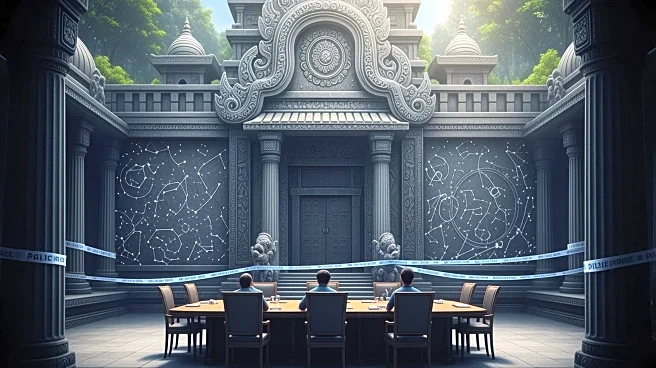What's Happening?
Archaeologists have uncovered new details about Aguada Fénix, the oldest and largest architectural site of the ancient Maya civilization, located in southeastern Mexico. Built 3,050 years ago, the site was used for around 300 years and features an artificial
plateau with causeways, canals, and corridors. Recent research published in Science Advances suggests the design of Aguada Fénix represents how the Maya conceived the universe, with a cruciform pattern symbolizing cosmic order. The site includes a large raised platform and a cruciform-shaped pit containing jade artifacts, aligned with significant dates in the Maya calendar. The construction required substantial labor, estimated at millions of days, yet shows no evidence of a social hierarchy, indicating it was built by willing participants rather than forced labor.
Why It's Important?
The discovery of Aguada Fénix provides significant insights into early Maya civilization, challenging previous assumptions about social organization and construction methods. The absence of hierarchical structures suggests that large-scale projects could be achieved through collective effort rather than centralized authority. This finding contributes to a broader understanding of Mesoamerican societies, highlighting the importance of ritual and cosmology in their cultural practices. The research also underscores the role of advanced remote sensing technologies like LiDAR in uncovering hidden archaeological sites, offering new perspectives on ancient civilizations and their development.
What's Next?
Further excavations and studies at Aguada Fénix are expected to continue, potentially revealing more about the social dynamics and cultural practices of early Maya civilization. Archaeologists may focus on understanding the site's role in regional interactions and its influence on subsequent Maya cities. The use of advanced technologies like LiDAR will likely expand to other areas, aiding in the discovery of additional sites and enhancing the understanding of Mesoamerican history. Researchers may also explore the implications of collective construction efforts on modern interpretations of ancient societies.
Beyond the Headlines
The findings at Aguada Fénix may prompt a reevaluation of how ancient societies organized labor and resources, challenging the notion that hierarchical structures are necessary for large-scale construction. This could influence contemporary discussions on social organization and community-driven projects. Additionally, the site's alignment with the Maya calendar highlights the sophisticated understanding of astronomy and time by ancient civilizations, offering insights into their worldview and its impact on cultural development.













